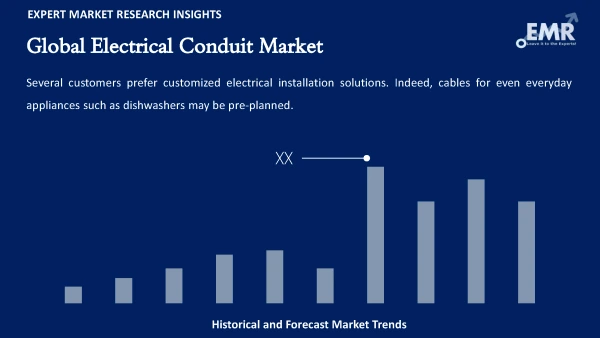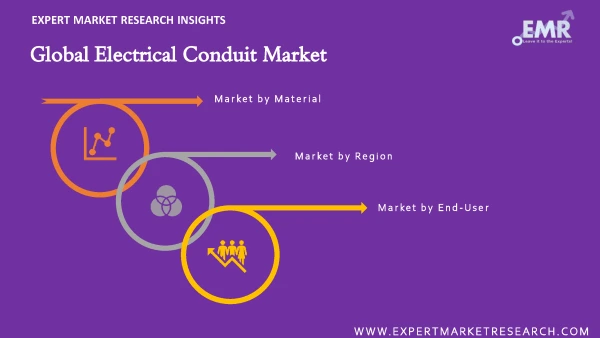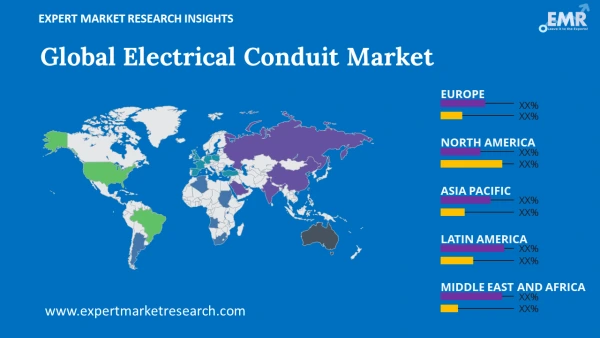Reports
Sale

Global Electrical Conduit Market Size, Growth, Forecast: By Material: Non-Metallic, Metallic; By End Use: Building and Construction, IT and Telecommunication, Industrial Manufacturing, Oil and Gas, Energy and Utility, Others; By Type: Rigid, Flexible; Regional Analysis; Market Dynamics: SWOT Analysis; Competitive Landscape; 2024-2032
Global Electrical Conduit Market Outlook
The global electrical conduit market is expected to grow at a CAGR of 7.4% during the period 2024-2032. The market is expected to be driven by growing demand for energy, increasing urbanization and infrastructure development activity, innovative solutions, and increased focus on and growth of energy efficient buildings. North America, Europe and Asia are expected to be key markets.

Read more about this report - REQUEST FREE SAMPLE COPY IN PDF
Global Market Likely to be Driven by Increasing Demand for Energy and Innovative Solutions
Growth in population has increased the need for construction and infrastructure development activities, including commercial and residential buildings. Such development has increased the demand for power generation, and power transmission and distribution material and accessories. These factors are expected to drive the market.
An electrical conduit is a duct, tube or pipe made of plastic or metal in which electrical wires are encased and routed. Common types of electrical conduits used for residential and commercial lighting include:
Electrical Metallic Tubing (EMT) – This is a common type of unbending conduit, generally made of galvanized steel or aluminium. This tube is commonly referred to as a thin-walled conduit because it is lighter and thinner than rigid metal conduit (RMC). While EMT may also be rigid, it may be readily bent with the help of a tube bender.
Rigid Metal Conduit (RMC) – This thick wall conduit is made of galvanized steel or aluminium. While RMC is expensive, it offers extra strength and durability.
Intermediate Metal Conduit (IMC) – This conduit is thicker than EMT but thinner than RMC. The weight of IMC also falls between that of EMT and RMC. IMCs are generally made of steel, and may be coated.
Flexible Metal Conduit (FMC) – This conduit has a spiral construction, and is very flexible. This flexibility enables FMC to go through walls and other structures.
Liquid-tight Flexible Metal Conduit (LFMC) – LFMC is a special type of flexible metal conduit employed where flexibility or protection from liquids, vapours or solids is required.
Electrical Non-Metallic Tubing- (ENT) – This is a thin-walled, flexible, corrugated conduit. It can be bent without the help a special device. However, these are usually snap-in connections and not watertight. However, liquid-tight flexible non-metallic condensate (LFNC) may be used in environments where there is moisture.
Rigid PVC Conduit – Rigid polyvinyl chloride (PVC) conduit is similar to plastic plumbing pipes and installed with plastic fittings that may be glued. The assembly can be watertight as conduit tubing and fittings are glued together. PVC enables underground applications. Further, it may be used in environments that cause rust.
Prewired Conduits Enabling Faster and Safer Installation Likely to Stimulate the Global Electrical Conduit Market
In the electrical installations segment, there is greater preference for prewired conduits for quicker, easier and safer installation, especially in markets where labour costs are high. Thus, prewired conduits are expected to witness greater demand.
High Quality, Innovative Solutions Expected to Boost Market Growth
Several customers prefer customized electrical installation solutions. Indeed, cables for even everyday appliances such as dishwashers may be pre-planned. Such solutions assume greater significance where there is shortage of skilled labour, and enable quicker installations and save significant time and money. Leading companies today offer innovative, pre-planned solutions to meet customer needs. For example, the Preflex Spider (by Pipelife) helps electricians save considerable time. Preflex Spider is an innovative system solution with the special feature that the electrical installation is prefabricated according to a digital design. The system comprises flexible, pre-wired electro conduits that need only be rolled out and connected at the site. Thus, the entire building may be wired efficiently and without any loose cables and devices spread around. Such innovative solutions are expected to contribute to the growth of the global electrical conduit market.
Market Segmentation

Read more about this report - REQUEST FREE SAMPLE COPY IN PDF
By material, the market is segmented into:
- Non-Metallic (further broken down by type as given below)
- Polyvinyl Chloride (PVC)
- Reinforced Thermosetting Resin (RTRC)
- Rigid Non-Metallic (RNC)
- Electrical Non-Metallic Tubing (ENT)
- Metallic (further broken down by type as given below)
- Rigid Metal Conduit (RMC)
- Galvanized Rigid Conduit (GRC)
- Intermediate Metal Conduit (IMC)
- Electrical Metal Tubing (EMT)
By end-user, the market is classified into:
- Building and Construction
- IT and Telecommunication
- Industrial Manufacturing
- Oil and Gas
- Energy and Utility
- Others
By type, the market is divided into:
- Rigid
- Flexible (further broken down by type as given below)
- Flexible Metallic Conduit (FMC)
- Liquid-Tight Flexible Metal Conduit (LFMC)
- Flexible Metallic Tubing Conduit (FMT)
- Liquid-Tight Flexible Non-Metallic Conduit (LFNC)
By region, the market is segmented into:
- North America (further broken down by country into)
- United States of America
- Canada
- Europe (further broken down by country into)
- United Kingdom
- Germany
- France
- Italy
- Others
- Asia Pacific (further broken down by country into)
- China
- Japan
- India
- ASEAN
- Australia
- Others
- Latin America (further broken down by country into)
- Brazil
- Argentina
- Mexico
- Others
- Middle East and Africa (further broken down by country into)
- Saudi Arabia
- United Arab Emirates
- Nigeria
- South Africa
- Others

Read more about this report - REQUEST FREE SAMPLE COPY IN PDF
Key Industry Players in the Global Electrical Conduit Market
The report presents a detailed analysis of the following key players in the market, looking into their capacity, and latest developments like capacity expansions, plant turnarounds, and mergers and acquisitions:
- Wienerberger AG
- Hubbell Incorporated
- ANAMET Electrical, Inc.
- Atkore International Inc.
- China Lesso Group Holdings Limited
- Zekelman Industries
- Others
The EMR report gives an in-depth insight into the industry by providing a SWOT analysis as well as an analysis of Porter’s Five Forces model.
Key Highlights of the Report
| REPORT FEATURES | DETAILS |
| Base Year | 2023 |
| Historical Period | 2018-2023 |
| Forecast Period | 2024-2032 |
| Scope of the Report |
Historical and Forecast Trends, Industry Drivers and Constraints, Historical and Forecast Market Analysis by Segment:
|
| Breakup by Material |
|
| Breakup by End Use |
|
| Breakup by Type |
|
| Breakup by Region |
|
| Market Dynamics |
|
| Competitive Landscape |
|
| Companies Covered |
|
| Report Price and Purchase Option | Explore our purchase options that are best suited to your resources and industry needs. |
| Delivery Format | Delivered as an attached PDF and Excel through email, with an option of receiving an editable PPT, according to the purchase option. |
*While we strive to always give you current and accurate information, the numbers depicted on the website are indicative and may differ from the actual numbers in the main report. At Expert Market Research, we aim to bring you the latest insights and trends in the market. Using our analyses and forecasts, stakeholders can understand the market dynamics, navigate challenges, and capitalize on opportunities to make data-driven strategic decisions.
1 Preface
2 Report Coverage – Key Segmentation and Scope
3 Report Description
3.1 Market Definition and Outlook
3.2 Properties and Applications
3.3 Market Analysis
3.4 Key Players
4 Key Assumptions
5 Executive Summary
5.1 Overview
5.2 Key Drivers
5.3 Key Developments
5.4 Competitive Structure
5.5 Key Industrial Trends
6 Snapshot
6.1 Global
6.2 Regional
7 Opportunities and Challenges in the Market
8 Global Electrical Conduit Market Analysis
8.1 Key Industry Highlights
8.2 Global Electrical Conduit Historical Market (2018-2023)
8.3 Global Electrical Conduit Market Forecast (2024-2032)
8.4 Global Electrical Conduit Market by Material
8.4.1 Non-Metallic
8.4.1.1 Historical Trend (2018-2023)
8.4.1.2 Forecast Trend (2024-2032)
8.4.1.3 Breakup by Type
8.4.1.3.1 Polyvinyl Chloride (PVC)
8.4.1.3.2 Reinforced Thermosetting Resin (RTRC)
8.4.1.3.3 Rigid Non-Metallic (RNC)
8.4.1.3.4 Electrical Non-Metallic Tubing (ENT)
8.4.2 Metallic
8.4.2.1 Historical Trend (2018-2023)
8.4.2.2 Forecast Trend (2024-2032)
8.4.2.3 Breakup by Type
8.4.2.3.1 Rigid Metal Conduit (RMC)
8.4.2.3.2 Galvanized Rigid Conduit (GRC)
8.4.2.3.3 Intermediate Metal Conduit (IMC)
8.4.2.3.4 Electrical Metal Tubing (EMT)
8.5 Global Electrical Conduit Market by End Use
8.5.1 Building and Construction
8.5.1.1 Historical Trend (2018-2023)
8.5.1.2 Forecast Trend (2024-2032)
8.5.2 IT and Telecommunication
8.5.2.1 Historical Trend (2018-2023)
8.5.2.2 Forecast Trend (2024-2032)
8.5.3 Industrial Manufacturing
8.5.3.1 Historical Trend (2018-2023)
8.5.3.2 Forecast Trend (2024-2032)
8.5.4 Oil and Gas
8.5.4.1 Historical Trend (2018-2023)
8.5.4.2 Forecast Trend (2024-2032)
8.5.5 Energy and Utility
8.5.5.1 Historical Trend (2018-2023)
8.5.5.2 Forecast Trend (2024-2032)
8.5.6 Others
8.6 Global Electrical Conduit Market by Type
8.6.1 Rigid
8.6.1.1 Historical Trend (2018-2023)
8.6.1.2 Forecast Trend (2024-2032)
8.6.2 Flexible
8.6.2.1 Historical Trend (2018-2023)
8.6.2.2 Forecast Trend (2024-2032)
8.6.2.3 Breakup by Type
8.6.2.3.1 Flexible Metallic Conduit (FMC)
8.6.2.3.2 Liquid-Tight Flexible Metal Conduit (LFMC)
8.6.2.3.3 Flexible Metallic Tubing Conduit (FMT)
8.6.2.3.4 Liquid-Tight Flexible Non-Metallic Conduit (LFNC)
8.7 Global Electrical Conduit Market by Region
8.7.1 North America
8.7.1.1 Historical Trend (2018-2023)
8.7.1.2 Forecast Trend (2024-2032)
8.7.2 Europe
8.7.2.1 Historical Trend (2018-2023)
8.7.2.2 Forecast Trend (2024-2032)
8.7.3 Asia Pacific
8.7.3.1 Historical Trend (2018-2023)
8.7.3.2 Forecast Trend (2024-2032)
8.7.4 Latin America
8.7.4.1 Historical Trend (2018-2023)
8.7.4.2 Forecast Trend (2024-2032)
8.7.5 Middle East and Africa
8.7.5.1 Historical Trend (2018-2023)
8.7.5.2 Forecast Trend (2024-2032)
9 North America Electrical Conduit Market Analysis
9.1 United States of America
9.1.1 Historical Trend (2018-2023)
9.1.2 Forecast Trend (2024-2032)
9.2 Canada
9.2.1 Historical Trend (2018-2023)
9.2.2 Forecast Trend (2024-2032)
10 Europe Electrical Conduit Market Analysis
10.1 United Kingdom
10.1.1 Historical Trend (2018-2023)
10.1.2 Forecast Trend (2024-2032)
10.2 Germany
10.2.1 Historical Trend (2018-2023)
10.2.2 Forecast Trend (2024-2032)
10.3 France
10.3.1 Historical Trend (2018-2023)
10.3.2 Forecast Trend (2024-2032)
10.4 Italy
10.4.1 Historical Trend (2018-2023)
10.4.2 Forecast Trend (2024-2032)
10.5 Others
11 Asia Pacific Electrical Conduit Market Analysis
11.1 China
11.1.1 Historical Trend (2018-2023)
11.1.2 Forecast Trend (2024-2032)
11.2 Japan
11.2.1 Historical Trend (2018-2023)
11.2.2 Forecast Trend (2024-2032)
11.3 India
11.3.1 Historical Trend (2018-2023)
11.3.2 Forecast Trend (2024-2032)
11.4 ASEAN
11.4.1 Historical Trend (2018-2023)
11.4.2 Forecast Trend (2024-2032)
11.5 Australia
11.5.1 Historical Trend (2018-2023)
11.5.2 Forecast Trend (2024-2032)
11.6 Others
12 Latin America Electrical Conduit Market Analysis
12.1 Brazil
12.1.1 Historical Trend (2018-2023)
12.1.2 Forecast Trend (2024-2032)
12.2 Argentina
12.2.1 Historical Trend (2018-2023)
12.2.2 Forecast Trend (2024-2032)
12.3 Mexico
12.3.1 Historical Trend (2018-2023)
12.3.2 Forecast Trend (2024-2032)
12.4 Others
13 Middle East and Africa Electrical Conduit Market Analysis
13.1 Saudi Arabia
13.1.1 Historical Trend (2018-2023)
13.1.2 Forecast Trend (2024-2032)
13.2 United Arab Emirates
13.2.1 Historical Trend (2018-2023)
13.2.2 Forecast Trend (2024-2032)
13.3 Nigeria
13.3.1 Historical Trend (2018-2023)
13.3.2 Forecast Trend (2024-2032)
13.4 South Africa
13.4.1 Historical Trend (2018-2023)
13.4.2 Forecast Trend (2024-2032)
13.5 Others
14 Market Dynamics
14.1 SWOT Analysis
14.1.1 Strengths
14.1.2 Weaknesses
14.1.3 Opportunities
14.1.4 Threats
14.2 Porter’s Five Forces Analysis
14.2.1 Supplier’s Power
14.2.2 Buyer’s Power
14.2.3 Threat of New Entrants
14.2.4 Degree of Rivalry
14.2.5 Threat of Substitutes
14.3 Key Indicators for Demand
14.4 Key Indicators for Price
15 Competitive Landscape
15.1 Market Structure
15.2 Company Profiles
15.2.1 Wienerberger AG
15.2.1.1 Company Overview
15.2.1.2 Product Portfolio
15.2.1.3 Demographic Reach and Achievements
15.2.1.4 Certifications
15.2.2 Hubbell Incorporated
15.2.2.1 Company Overview
15.2.2.2 Product Portfolio
15.2.2.3 Demographic Reach and Achievements
15.2.2.4 Certifications
15.2.3 ANAMET Electrical, Inc.
15.2.3.1 Company Overview
15.2.3.2 Product Portfolio
15.2.3.3 Demographic Reach and Achievements
15.2.3.4 Certifications
15.2.4 Atkore International Inc.
15.2.4.1 Company Overview
15.2.4.2 Product Portfolio
15.2.4.3 Demographic Reach and Achievements
15.2.4.4 Certifications
15.2.5 China Lesso Group Holdings Limited
15.2.5.1 Company Overview
15.2.5.2 Product Portfolio
15.2.5.3 Demographic Reach and Achievements
15.2.5.4 Certifications
15.2.6 Zekelman Industries
15.2.6.1 Company Overview
15.2.6.2 Product Portfolio
15.2.6.3 Demographic Reach and Achievements
15.2.6.4 Certifications
15.2.7 Others
16 Key Trends and Developments in the Market
List of Figures and Tables
1. Global Electrical Conduit Market: Key Industry Highlights, 2017 and 2021
2. Global Electrical Conduit Historical Market: Breakup by Material (USD Million), 2018-2023
3. Global Electrical Conduit Market Forecast: Breakup by Material (USD Million), 2024-2032
4. Global Electrical Conduit Historical Market: Breakup by End-User (USD Million), 2018-2023
5. Global Electrical Conduit Market Forecast: Breakup by End-User (USD Million), 2024-2032
6. Global Electrical Conduit Historical Market: Breakup by Type (USD Million), 2018-2023
7. Global Electrical Conduit Market Forecast: Breakup by Type (USD Million), 2024-2032
8. Global Electrical Conduit Historical Market: Breakup by Region (USD Million), 2018-2023
9. Global Electrical Conduit Market Forecast: Breakup by Region (USD Million), 2024-2032
10. North America Electrical Conduit Historical Market: Breakup by Country (USD Million), 2018-2023
11. North America Electrical Conduit Market Forecast: Breakup by Country (USD Million), 2024-2032
12. Europe Electrical Conduit Historical Market: Breakup by Country (USD Million), 2018-2023
13. Europe Electrical Conduit Market Forecast: Breakup by Country (USD Million), 2024-2032
14. Asia Pacific Electrical Conduit Historical Market: Breakup by Country (USD Million), 2018-2023
15. Asia Pacific Electrical Conduit Market Forecast: Breakup by Country (USD Million), 2024-2032
16. Latin America Electrical Conduit Historical Market: Breakup by Country (USD Million), 2018-2023
17. Latin America Electrical Conduit Market Forecast: Breakup by Country (USD Million), 2024-2032
18. Middle East and Africa Electrical Conduit Historical Market: Breakup by Country (USD Million), 2018-2023
19. Middle East and Africa Electrical Conduit Market Forecast: Breakup by Country (USD Million), 2024-2032
20. Global Electrical Conduit Market Structure
Datasheet
-
Selected Sections, One User
-
Printing Not Allowed
-
Email Delivery in PDF
-
Free Limited Customisation -
Post Sales Analyst Support -
50% Discount on Next Update
Single User License
-
All Sections, One User
-
One Print Allowed
-
Email Delivery in PDF
-
Free Limited Customisation -
Post Sales Analyst Support -
50% Discount on Next Update

Five User License
-
All Sections, Five Users
-
Five Prints Allowed
-
Email Delivery in PDF
-
Free Limited Customisation
-
Post Sales Analyst Support
-
50% Discount on Next Update
Corporate License
-
All Sections, Unlimited Users
-
Unlimited Prints Allowed
-
Email Delivery in PDF + Excel
-
Free Limited Customisation
-
Post Sales Analyst Support
-
50% Discount on Next Update
Any Question? Speak With An Analyst
View A Sample
Did You Miss Anything, Ask Now
Right People
We are technically excellent, strategic, practical, experienced and efficient; our analysts are hand-picked based on having the right attributes to work successfully and execute projects based on your expectations.
Right Methodology
We leverage our cutting-edge technology, our access to trusted databases, and our knowledge of the current models used in the market to deliver you research solutions that are tailored to your needs and put you ahead of the curve.
Right Price
We deliver in-depth and superior quality research in prices that are reasonable, unmatchable, and shows our understanding of your resource structure. We, additionally, offer attractive discounts on our upcoming reports.
Right Support
Our team of expert analysts are at your beck and call to deliver you optimum results that are customised to meet your precise needs within the specified timeframe and help you form a better understanding of the industry.


